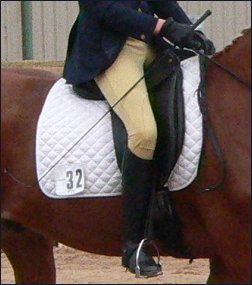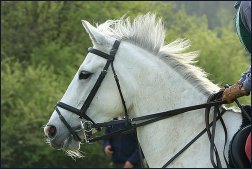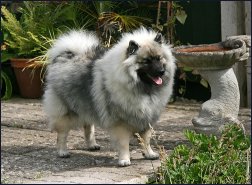|
  BY
THE2NDCAVALERY
BY
THE2NDCAVALERY
Riding
aids are a way of the horse and rider communicating together on the
same level. They consist of two categories; Natural and Artificial.
When riding, you should always use the correct aids at the right
moments to avoid misunderstandings between you and the horse. There are
different types of aids for different levels of riding and riders
experience, you should never use an aid that you aren't sure how to use
properly, because this may be teaching the horse something other then
what you have in mind.

Natural riding aids are, well, what momma gave
you. They
are your hands, voice, seat and legs. Depending on the level of the
horses training all aids could be done completely naturally, with or
without tack on the horse. Your hands may be used with one of the
artificial aids (bit and reins) to help guide and collect the horse,
but it is also always important to keep “quiet”
hands;
never pulling on a horse’s mouth, the hands should never be
over
used, because this may cause irritation and annoyance to the horse,
creating bad habits. Voice isn’t as commonly used, but is
still a
natural aid, many horses will understand the tone of voice, and simple
commands such as whoa, walk, trot, and canter. The seat and legs are
the most important natural aids to riding; many experienced riders can
ride horses just using the seat and legs. A properly trained horse
should, with pressure on the right side, move away from the pressure,
turning left, and if pressured on the left side the horse should turn
right. 

The Artificial aids include: Bit, reins, spurs,
and whip
or crop. These are the aids that if used improperly can frighten, or
change the natural personality of the horse, but when used properly and
effectively should help expand the horses learning and potential. The
bit is a piece of metal attached to the bridle and reins which goes in
the horses’ mouth. This, as explained earlier is used with
the
natural aid of hands. Depending on the experience of the rider and the
personality of the horse, bits can range from the softest like certain
types of Snaffle, to the harsher Gag bits. The bit also majorly depends
on the riders experience, with the right hands the Gag, could be as
soft as a snaffle, and on the other hand, the Snaffle can be just as
harsh as the Gag. The spur is a metal piece that is attached to the
back of riders boots, and is used as an extension of the riders leg,
the wrong type of spurs, or spurs worn by inexperienced riders, may
draw blood and shouldn’t be worn by the rider unless they
know
what they're doing. The whip and crop have the same intentions but
the whip is usually twice the length of a crop. Even though the
whip/crop is used in hand, it’s meant as an extension of the
leg
for a faster response if the horse does not respond to the leg
immediately. Also, depending on if a rider shows, in lower showing
levels, whips are not permitted to be used. 
The point of the artificial aids is to help the
natural
aids only when needed and lightly if needed. Many artificial aids help
when training a young green horse but should not be over done for it
may traumatize the horse making them more scared of its rider than
respectful of them.

|
  BY TONYZBELLA
BY TONYZBELLA
He has spectacles, his hair is liberally spattered
with
silver, he’s well known as a friendly sort, he’s a
sailor
and he’s foreign! Swoon and cue the flowery speech and sappy
love
scenes. Sounds like a character out of a romance novel right? Maybe,
but this lover boy has four legs not two. I’m not talking
about a
heart stopping Dutch pirate ready to sweep you off your feet;
I’m
talking about the Dutch Barge Dog, otherwise known as the Keeshond.
 PHOTO
BY MARILYN JANE AT SWASHWAY KENNELS
PHOTO
BY MARILYN JANE AT SWASHWAY KENNELS
These dogs are part of the German spitz
family and
in fact were not a separate breed at all, neither were any of the now
recognized spitz breeds, like the Pomeranian, and American Eskimo Dog.
It was a matter of coat color and size. Though today you’d be
hard pressed to find a Keeshond in any color other than wolf gray, they
were once crossed with their spitz brethren and came in a variety of
colors. All of which can be found in the spitz breeds today. Most spitz
breeds now focus on specific coat colors for their breed. The Keeshond
or Wolfsspitz, as they were originally called, is the only spitz breed
where one coat color is focused on. Because of their previous breeding
Keeshonden of colors other than wolf coat do occur. However they are
not breed standard and are considered pet quality only. It is being
debated now among breeders whether or not Keeshonden should be bred for
other colors as they once were.
The Keeshond is very intelligent and as
such excels
in training. They are used primarily in obedience and agility work, but
some have even been used as guide dogs. They are widely used as guard
dogs in the Netherlands and middle Europe. Their loud bark and alert
nature make them especially suited to the job.
Please note the Keeshond is a wonderful
guard dog,
they are however not useful as attack dogs. Their playful nature and
welcoming, friendly, personality keeps them from being aggressive, in
fact their nickname, “The Smiling Dutchman” comes
from the
huge grin and lolling tongue they often present to everyone they meet.
Their intelligence can also lead to
problems, they
are eager to please, but they learn very fast, often learning things
you wish they wouldn’t! Keeshonden are not a
beginner’s dog
and need an experienced dog owner and proper training. Otherwise they
can and will learn ways to amuse themselves, such as chewing the legs
of your grandmother’s 18th century dining chairs. They bond
to
their owners very deeply and are often used as comfort dogs. One was at
ground zero on 9-11 to comfort those in need. They bond so deeply they
are often called “velcro dogs”; as a result they
make the
perfect family dog. Just make sure they get lots of activity, as they
are also very active by nature.
Health wise the Keeshond is
unfortunately prone to
several problems. Among them are hip dysplasia, luxating patellas,
epilepsy, Cushing’s disease, primary hyperparathyroidism and
rarely Von Willebrand’s disease. This can be avoided if you
research the parents and blood line of any Keeshond you intend to buy.
Make sure |
the
parents have been tested for any hereditary diseases and that there
is not a history of disease in the blood line. Most health problems are
the result of irresponsible breeding.
Once a week for about an hour is
usually sufficient
grooming, as
Keeshonden are naturally dirt and water resistant. They rarely have an
odor unless not properly cared for; they have a natural oil balance in
their coat and should not be washed more than absolutely necessary.
Shaving or cutting a Keeshond’s coat is not recommended as
the
coat
insulates them against weather and insects. Shaving the coat cuts the
distinctive guard hairs off and will ruin the look of the
Keeshond’s
natural coat. Shaving can also result in a permanent loss of their
natural look, because once shaved it cannot be guaranteed that the coat
will regrow properly. Some dogs have to be “tarred”
because
living in
air conditioned and heated environments dry the coat. Speak to your
groomer if your Keeshond’s coat appears to be dry or brittle
and
if
they seem to be having itching problems resulting from dry skin.
The Keeshond gained its name from
Cornelius (Kees)
de Gyselar,
leader of the Dutch rebellion against the House of Orange. The Keeshond
became their symbol and when the house was returned to power the breed
almost went extinct. Keeshond is a compound word using
“Kees”, a nick
name for Cornelius de Gyselar, and “hond” the Dutch
word
for dog. They
were also used as barge dogs and thus came the name Dutch Barge Dog,
which was in common usage in England until 1926.
While it is commonly held that the
Keeshond
originated in the
Netherlands it is now known that it originated in Germany along with
all the other German spitzes.
On VP, the breed is not very popular
and would
probably be
considered rare, there are only eighty six in the game, most of which
are owned by “Puppy Palace” Kennel # 20570. Puppy
Palace is
a rescue
kennel and has, based on its web page, gotten Keeshonden to 8x4, I was
unable to contact the owner and do not know if they are still active in
the game. Despite this some have been evented, particularly Delayed
Reaction, owned by summerbreeze5 of Shady Oasis Dog Kennels (#5003),
who is also purported to be the first Keeshond in the game. I was also
unable to contact Delayed Reaction’s owner and do not know if
they are
still active in game. Keeshonden seem to do best in either Agility or
fly ball with mushing as a possible third option.
The highest stats I could find at birth
for a
Keeshond were:
Friendly: 89.3
Aggression: 80
Adaptability: 98.4
Loyalty: 69.4
Courage 89.4
Hyper 86.3
Strength 80.4
Intelligence 92.5
Endurance 75.6
Speed 80.8
Perhaps in the future the Keeshond
breed will
become more popular
on VP. However after five years it seems unlikely the breed will
suddenly see a sudden bloom in popularity. Most are owned by kennels
which seem to no longer be active, and those which are not, do not seem
to be in use.
|
|



